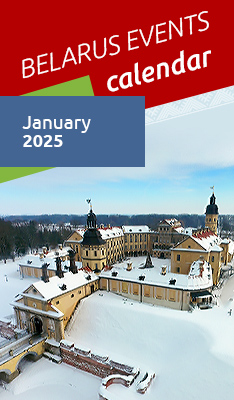Become a partner in a humanitarian project
Humanitarian project “Museum Without Borders”

Project name: Museum Without Borders
Applicant: Pavel Maslenikov Mogilev Regional Art Museum
Address: 33 Mironova Street, Mogilev, 212030, Republic of Belarus
Phone: +375 222 766121
E-mail: info@maslenikov.by
The Pavel Maslenikov Mogilev Regional Art Museum is located in the center of Mogilev. The museum building is an architectural specimen of the early 20th century. It was designed by architect A.V. Drucker on the orders of a peasant bank. In 1917, the building housed a publishing house of the Revolutionary Headquarters newspaper. Since May 1919, it hosted the Mogilev State History Museum. Its most valuable items included the Cross of Euphrosyne of Polotsk made by Lazar Bogsha in 1161, a collection of Belarusian handwritten books and letters (175 items), weapons of the 10th-14th centuries (280 items), coins (1,800 items), icons of the 17th-19th centuries, a mace of Sigismund III, paintings by Ivan Aivazovsky, Ilya Repin, Valentin Serov and other famous artists, a miter of Mogilev Archbishop Georgy Konissky, a shroud of Anna Paletskaya, a close relative of Ivan the Terrible’s wife Anastasia Romanovna (made in 1566), the first printed Menaion, royal letters of the 16th –18th centuries (26 items), handwritten irms of 1697 with drawings. When the Great Patriotic War began, the exhibits were taken out of Mogilev and their whereabouts remain unknown.
In 1944, after the liberation of the city, the building housed the regional committee and city committee of the Communist Party, after that the editorial office of the Mogilevskaya Pravda newspaper. On 19 November 1990, the Mogilev Regional Art Museum was opened here. On 28 July 1994, the country’s first gallery of Pavel Maslenikov, the People’s Artist of Belarus, opened in the museum. In 1996 the Mogilev Regional Art Museum was named after Pavel Maslenikov.
Since 1 January 2021 the museum has been running a branch in Belynichi - the Byalynitsky-Birulya Art Museum.
To date, the Pavel Maslenikov Mogilev Regional Art Museum hosts the following permanent exhibitions: Art Gallery of the People's Artist of Belarus Pavel Maslenikov, Preserved Heritage, The Secret of the Cross.
The museum boasts the mid-18th century wall paintings that were removed from the stairs of the Carmelite Monastery in Belynichi. In 1978, the remains of the monastery had to be blown up. The frescoes were removed from the staircase and sent to Minsk for conservation. This specimen of monumental art is one of the kind in the post-Soviet space. To date, the frescoes The Transfiguration and Carrying the Cross are featured in the Preserved Heritage exposition.
Since 1996, the museum has been hosting plein air sessions dedicated to famous artists of Mogilev Oblast, art critics, and significant events. For many years, artists from Belarus, Lithuania, Israel, India, China, Serbia, Poland, Russia, Ukraine and other countries have taken part in them. Plein air sessions are complemented by master classes, creative meetings, evenings of national cultures.
The museum has successfully implemented many large-scale art projects.
In November 2020 the museum launched a doll making studio. It arranged children’s art competitions, developed multimedia products like educational platforms and video tours and increased its presence in social media.
The total number of core exhibits is 6,242 items, the auxiliary collection holds about 1,713 items.
Museum director: Yelena Bobrova,
Phone: +375 222 78 21 24
Project Manager: Nikolai Gaida, Deputy Director
Phone: +375 222 62 20 15
E-mail: info@maslenikov.by
Assistance received from other foreign sources: foreign gratuitous aid - paintings for museum collections and expositions.
-
Total financing (in USD): 40,000
-
Co-funding: Not available
Project period: 1 year
Project goals:
- making the museum accessible for visually impaired people;
- teaching children how to interact with people with disabilities;
- running educational and cultural projects for children and people with special needs;
- introducing interactive technologies to enhance the museum experience for people with disabilities;
- promoting religious and cultural tolerance through interactive excursions and programs.
Project tasks:
- purchasing modern equipment (touch screens with audio and video support in Belarusian, Russian, English and Chinese, a video projector and an acoustic system) to make the visitor experience more interactive and the museum more attractive to various audiences;
- making the museum more accessible to visually impaired people;
- adding interactive models for better perception of information by visually impaired people and children;
- recording excursions for off-site events in boarding houses and boarding schools for people with disabilities.
Brief description:
• Developing a virtual tour of the museum exposition.
• Running inclusive cultural and educational programs that recognize all children as individuals with different learning needs.
• Conducting mixed interactive tours for schoolchildren and people with disabilities in order to teach children to interact with people with special needs and introduce them to the cultural heritage of the country in an interactive form.
• Arranging interactive excursions for mixed groups consisting of representatives of different religious denominations to foster tolerance and build contacts between people having different backgrounds.
• Purchasing modern equipment to use interactive teaching methods.
• Buying the necessary furniture and tools, interactive equipment, a suspension system, lighting, sound systems for exposition halls, software (development of an application for an independent study of the museum exposition).
Project substantiation:
The project will help create a barrier-free environment for museum visitors. The limited communication and social activity adds to psychological, economic and other kinds of problems for the disabled and their loved ones. The acquisition of the necessary equipment will help improve access to cultural and educational activities, facilitate social adaptation and empowerment of people with special needs.
Post-project activities:
The implementation of the project will improve the quality of museum services for people with disabilities, provide an unobstructed access to cultural events and activities and thus improve the quality of life of such people.









 print version
print version make home page
make home page add to bookmarks
add to bookmarks

